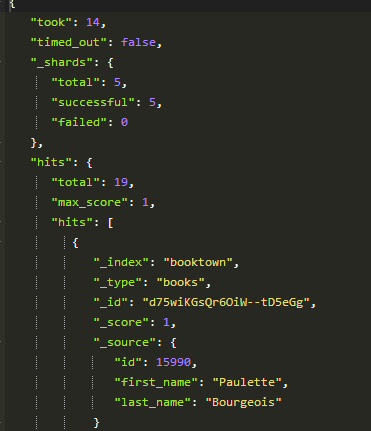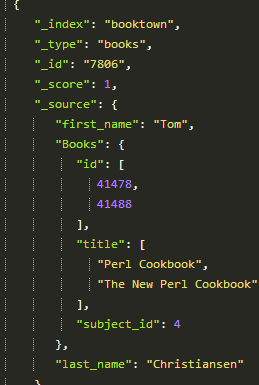Elasticsearch: Indexing SQL databases. The easy way
Elasticsearchis a great search engine, flexible, fast and fun. So how can I get started with it? This post will go through how to get contents from a SQL database into Elasticsearch.
Elasticsearch has a set of pluggable services called rivers. A river runs inside an Elasticsearch node, and imports content into the index. There are rivers for twitter, redis, files, and of course, SQL databases. The river-jdbc plugin connects to SQL databases using JDBC adapters. In this post we will use PostgreSQL, since it is freely available, and populate it with some contents that also are freely available.
So let’s get started
- Download and install Elasticsearch
- Start elasticsearch by running bin/elasticsearch from the installation folder
- Install the river-jdbc plugin for Elasticsearch version 1.00RC
1./bin/plugin -install river-jdbc -url <em><a href="http://bit.ly/1dKqNJy">http://bit.ly/1dKqNJy</a> </em>
- Download the PostgreSQL JDBC jar file and copy into the plugins/river-jdbc folder. You should probably get the latest version which is for JDBC 41
- Install PostgreSQL http://www.postgresql.org/download/
- Import the booktown database. Download the sql file from booktown database
- Restart Elasticsearch
- Start PostgreSQL
By this time you should have Elasticsearch and PostgreSQL running, and river-jdbc ready to use.
Now we need to put some contents into the database, using psql, the PostgreSQL command line tool.
|
1
|
psql -U postgres -f booktown.sql
|
To execute commands to Elasticsearch we will use an online service which functions as a mixture of Gist, the code snippet sharing service and Sense, a Google Chrome plugin developer console for Elasticsearch. The service is hosted by http://qbox.io, who provide hosted Elasticsearch services.
Check that everything was correctly installed by opening a browser tohttp://sense.qbox.io/gist/8361346733fceefd7f364f0ae1ebe7efa856779e
Select the top most line in the left-hand pane, press CTRL+Enter on your keyboard. You may also click on the little triangle that appears to the right, if you are more of a mouse click kind of person.
You should now see a status message, showing the version of Elasticsearch, node name and such.
Now let’s stop fiddling around the porridge and create a river for our database:
|
1
2
3
4
5
6
7
8
9
10
11
12
13
|
curl -XPUT "http://localhost:9200/_river/mybooks/_meta" -d'
{
"type": "jdbc",
"jdbc": {
"driver": "org.postgresql.Driver",
"url": "jdbc:postgresql://localhost:5432/booktown",
"user": "postgres",
"password": "postgres",
"index": "booktown",
"type": "books",
"sql": "select * from authors"
}
}'
|
This will create a “one-shot” river that connects to PostgreSQL on Elasticsearch startup, and pulls the contents from the authors table into the booktown index. The index parameter controls what index the data will be put into, and the type parameter decides the type in the Elasticsearch index. To verify the river was correctly uploaded execute
|
1
|
GET /_river/mybooks/_meta
|
Restart Elasticsearch, and watch the log for status messages from river-jdbc. Connection problems, SQL errors or other problems should appear in the log . If everything went OK, you should see something like …SimpleRiverMouth] bulk [1] success [19 items]
Time has come to check out what we got.
|
1
|
GET /booktown/_search
|
You should now see all the contents from the authors table. The number of items reported under “hits” -> “total” are the same as what we just saw in the log: 19.

But looking more closely at the data, we can see that the _id field has been auto-assigned with some random values. This means that the next time we run the river, all the contents will be re-added.
Luckily, river-jdbc support somespecially labeled fields, that let us control how the contents should be indexed.
Reading up on the docs, we change the SQL definition in our river to
|
1
2
|
select id as _id, first_name,
last_name from authors
|
We need to start afresh and scrap the index we just created:
|
1
|
DELETE /booktown
|
Restart Elasticsearch. Now you should see a meaningful id in your data.
At this time we could start toying around with queries, mappings and analyzers. But, that’s not much fun with this little content. We need to join in some tables and get some more interesting data. We can join in the books table, and get all the books for all authors.
|
1
2
3
|
SELECT authors.id as _id, authors.last_name, authors.first_name,
books.id, books.title, books.subject_id
FROM public.authors left join public.books on books.author_id = authors.id
|
Delete the index, restart Elasticsearch and examine the data. Now you see that we only get one book per author. Executing the SQL statement in pgadmin returns 22 rows, while in Elasticsearch we get 19. This is on account of the _id field, on each attempt to index an existing record with the same _id as a new one, it will be overwritten.
River-jdbc supports Structured objects, which allows us to create arbitrarily structured JSON documents simply by using SQL aliases. The _id column is used for identity, structured objects will be appended to existing data. This is perhaps best shown by an example:
|
1
2
3
4
|
SELECT authors.id as _id, authors.last_name, authors.first_name,
books.id as \"Books.id\", books.title as \"Books.title\",
books.subject_id as \"Books.subject_id\"
FROM public.authors left join public.books on books.author_id = authors.id order by authors.id
|
Again, delete the index, restart Elasticsearch, wait a few seconds before you search, and you will find structured data in the search results.

Now we have seen that it is quite easy to get data into Elasticsearch using river-jdbc. We have also seen how it can handle updates. That gets us quite far. Unfortunately, it doesn’t handle deletions. If a record is deleted from the database, it will not automatically be deleted from the index. There have been some attempts to create support for it, but in the latest release it has been completely dropped.
This is due to the river plugin system having some serious problems, and it will perhaps be deprecated some time after the 1.0 release, at least not actively promoted as “the way”. (see the “semi-offical statement” at Linkedin Elasticsearch group). While it is extremely easy to use rivers to get data, there are a lot of problems in having a data integration process running in the same space as Elasticsearch itself. Architecturally, it is perhaps more correct to leave the search engine to itself, and build integrations systems on the side.
Among the recommended alternatives are:
>Use an ETL tool like Talend
>Create your own script
>Edit the source application to send updates to Elasticsearch
Jörg Prante, who is the man behind river-jdbc, recently started creating a replacement calledGatherer.
It is a gathering framework plugin for fetching and indexing data to Elasticsearch, with scalable components.
Anyway, we have data in our index! Rivers may have their problems when used on a large scale, but you would be hard pressed to find anything easier to get started with. Getting data into the index easily is essential when exploring ideas and concepts, creating POCs or just fooling around.
This post has run out of space, but perhaps we can look at some interesting queries next time?
Elasticsearch: Indexing SQL databases. The easy way的更多相关文章
- [Android 开发教程(1)]-- Saving Data in SQL Databases
Saving data to a database is ideal for repeating or structured data, such as contact information. Th ...
- ElasticSearch安装SQL插件
ElasticSearch安装SQL插件下载地址(中国大佬开发的,膜拜ing):https://github.com/NLPchina/elasticsearch-sql 1.记得选择和自己Elast ...
- 十四、.net core(.NET 6)搭建ElasticSearch(ES)系列之给ElasticSearch添加SQL插件和浏览器插件
给ES添加SQL插件的方法: 下载SQL插件地址:https://github.com/NLPchina/elasticsearch-sql 当前最新的是7.12版本,我的ES是7.13版本,暂且将 ...
- Android学习笔记——保存数据到SQL数据库中(Saving Data in SQL Databases)
知识点: 1.使用SQL Helper创建数据库 2.数据的增删查改(PRDU:Put.Read.Delete.Update) 背景知识: 上篇文章学习了保存文件,今天学习的是保存数据到SQL数据库中 ...
- 安装支持elasticsearch使用sql查询插件
一.ElasticSearch-SQL介绍 ElasticSearch-SQL(后续简称es-sql)是ElasticSearch的一个插件,提供了es 的类sql查询的相关接口.支持绝大多数的sql ...
- Exam 70-762 Developing SQL Databases
这个考试还是很有用的,教了很多有用的东西,不错,虽然考试需要很多钱,不过值的尝试.虽然用了sql server 这么多年但是对于事务.多并发的优化还是处于小学生的水平,通过这次考试争取让自己提一个档次 ...
- 使用Hive或Impala执行SQL语句,对存储在Elasticsearch中的数据操作(二)
CSSDesk body { background-color: #2574b0; } /*! zybuluo */ article,aside,details,figcaption,figure,f ...
- 使用Hive或Impala执行SQL语句,对存储在Elasticsearch中的数据操作
http://www.cnblogs.com/wgp13x/p/4934521.html 内容一样,样式好的版本. 使用Hive或Impala执行SQL语句,对存储在Elasticsearch中的数据 ...
- Spark SQL大数据处理并写入Elasticsearch
SparkSQL(Spark用于处理结构化数据的模块) 通过SparkSQL导入的数据可以来自MySQL数据库.Json数据.Csv数据等,通过load这些数据可以对其做一系列计算 下面通过程序代码来 ...
随机推荐
- 《2016ThoughtWorks技术雷达峰会----雷达新趋势》
雷达新趋势 徐昊,ThoughtWorks中国区CTO 1.Open Source open source 已经从一个简简单单的软件代码组织方式变成一种文化,一种运动.当谈到Open Sour ...
- LoadRunner11.0下载及安装链接~(By网络)
Download and install O(∩_∩)O: http://www.jb51.net/softjc/71256.html
- UIWrapContent(NGUI长列表优化利器)
NGUI长列表优化利器 优化原理 NGUI3.7.x以上版本 有个新组件 UIWrapContent ,当我们的列表内容很多时,可以进行优化.它不是一次生成全部的child,而是只有固定数量的chil ...
- junit 测试及assert的扩张
@Testpublic void method() 测试注释指示该公共无效方法它所附着可以作为一个测试用例. @Beforepublic void method() Before注释表示,该方法必须在 ...
- [No000043]学习Linux操作系统必备基础知识
Linux操作系统概述 Q1.什么是GNU?Linux与GNU有什么关系? A: 1)GNU是GNU is Not Unix的递归缩写,是自由软件基金会(Free Software Foundatio ...
- 封装第三方jquery插件
需要自己编写 directives 的情况通常是当你使用了第三方的 jQuery 插件.因为插件在 AngularJS 之外对表单值进行更改,并不能即时反应到 Model 中.例如我们用得比较多的 j ...
- HTML 学习笔记 CSS(选择器4)
CSS 后代选择器 后代选择器(descendant selector)又称为包含选择器.后代选择器可以选择作为某元素后代的元素. 根据上下文选择元素 我们可以定义后代选择器来创建一些规则,使这些规则 ...
- Jenkins 安装
1. 调整tomcat的jvm配置, 以免内存不够, 在catalina.sh中 #!bin/sh下添加 JAVA_OPTS="-server -Xms1024m -Xmx1024m -XX ...
- “Word自动更改后的内容保存到通用文档模板上。是否加载该模板?“的解决办法
在win7系统下,Word2010出现了不能正常关闭.打开一个已有word文档,点击右上角关闭按钮后,先提示"word已停止工作,windows正在检查该问题的解决方案",随后提示 ...
- C#并行编程中的Parallel.Invoke
一.基础知识 并行编程:并行编程是指软件开发的代码,它能在同一时间执行多个计算任务,提高执行效率和性能一种编程方式,属于多线程编程范畴.所以我们在设计过程中一般会将很多任务划分成若干个互相独立子任务, ...
